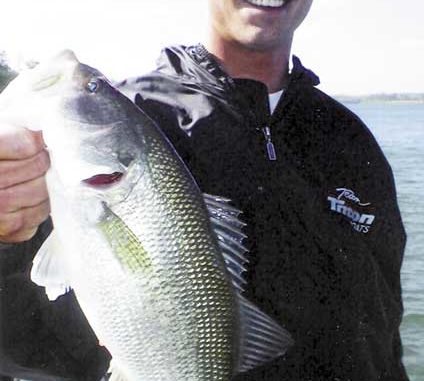
Fish timber and brush this month for easy Lake Russell bass bites.
After a morning of intermittent success on topwater lures fished points and blowthroughs, Casey Ashley guided his boat purposefully through a field of standing timber.It’s high noon at Lake Russell — certainly not prime time for inducing bass to bite — but Ashley loves a good challenge.
“This is the best part about this lake, right here,” Ashley said, nodding toward an assemblage of cedars, oaks and other hardwood trees that stand as sentinels in the reservoir.
The change in scenery called for a change in tactics, and Ashley obliged by tying on a spinnerbait and lofting it past a crooked, sun-bleached limb. His retrieve was deliberate as he felt what was beneath the surface.
“You want to knock it on every piece of wood you can,” Ashley said.
This bit of advice had barely left Ashley’s lips when he jerked his rod tip upward, tightening his line on the best bass of the day. Within seconds, he lipped a largemouth that easily broke the 4-pound mark, pausing to admire it for a minute before slipping it back into the water.
“Now that’s more like it,” he said.
The big bass, and two more that followed in rapid succession, came as no surprise to Ashley.
Because, at Lake Russell, it’s all about the timber.
“Timber? No other lake’s got it like this,” Ashley said. “It’s full of it. I mean absolutely loaded.”
No one knows this better than Ashley, who lives in the nearby town of Donalds and has been fishing Russell’s waters for more than half of his 24 years.
“When they built the lake, they cleared everything out to about 30 feet,” Ashley said. “But from 30 feet on out, it’s nothing but standing timber. So this lake is a very offshore lake. If you fish the bank around here, you might catch some small ones in spring when the fish are coming in to spawn, but that’s about it. A lot of the bigger fish will spawn out in the timber.”
In the summer, they can be even more difficult to catch. Bass will suspend in the timber, where they typically don’t chase baitfish, but rather just lazily wait for them to happen by.
“I’ve never figured out how to catch ’em consistently,” Ashley said. “Some days you’ll come out here and catch a lot and you’ll think you’ve figured ’em out. Then you’ll come back the next day and not catch ’em like that.”
A fast-rising star on the Bassmaster Elite Series who finished 17th in his first Bassmaster Classic appearance last February at Lake Hartwell, Ashley remains fond of Russell despite its unpredictability and the difficulty in patterning the reservoir’s bass.
As a teenager, he competed in local tournaments on Russell like clockwork every Wednes-day night and Saturday — a habit that’s been hard for him to break, even as he’s found success at bass fishing’s highest level.
When he returned from an tournament last year in California, he was on Russell the next day, finishing second in a local tournament with five bass totaling 19 pounds.
“This lake probably isn’t regarded as as good of a bass fishery as Clarks Hill or Hartwell, because everybody knows about them,” Ashley said. “But I love coming here … always have and probably always will. I’ve got a couple of friends who are real good here, and they’ve taught me a lot. Every day, you learn something here. And this place will make you get good because it can be tough.”
Lake Russell is the newest reservoir on a Savannah River system that straddles South Carolina-Georgia border. It reached full pool for the first time in 1994, providing anglers with another 26,000 acres of fishable water.
But in many ways, Russell remains a largely overlooked commodity, primarily because it is sandwiched between more popular Hartwell and Clarks Hill. With more than 10 million visitors annually, Hartwell ranks among the top three most-visited U.S. Army Corps of Engineers lakes in the nation; at 71,000 acres, Clarks Hill is the largest Corps project east of the Mississippi River.
Lake Russell is, well, different.
“That’s one good thing about Russell,” Ashley said. “You can come over here and not have to worry about all the jet skis, speedboats and all that stuff.”
In that sense, Russell truly could be considered an “angler’s lake.” The shoreline is largely undeveloped, there are plenty of access points, and boater-friendly marker poles designate the channel edges.
Shaped something like a wild turkey’s footprint, Russell is a 3-pronged reservoir, fed by Beaverdam Creek to the west, the Savannah River to the north and the Rocky River to the northeast. Standing timber is the bass cover for a couple of miles up each waterway.
“A lot of the timber tops out at about eight feet (below the surface),” Ashley said. “The bass will hang out there and suspend in the tops of the trees. They relate to those trees because that’s about all that’s out there, and that way they always have an escape route.
“It’s not that they’re real finicky — it’s just that they suspend and can be tough to figure out. You take can a big crankbait or a spinnerbait and run it through the tops of those trees and catch some big ones, but like I said before, you may come back the next day and not get a bite.”
Another angler who has experienced similar highs and lows at Russell is Trad Whaley of Abbeville, a regular on the FLW’s BFL circuit who has been plying Russell’s waters since the lake was beginning to fill up in the mid-1980s. But he hasn’t fished the water that long without developing some sound strategies.
“The key is to find out where the timber starts and stops,” Whaley said. “I like to get in the middle of the creeks where the last timber line is and crank over the tops of the trees or slow-roll a spinnerbait or even flip a worm along the sides of the trees. I do the same if I find timber on a main lake point, then I look for that one lone tree off by itself. But you’d better be using at least 20-pound test, because it can be tough to get ’em out of there.”
Although the allure of the timber is always present, there are plenty of other hot spots around the lake. Whaley contends that anyone can catch bass at Russell — and they don’t have to be in the middle of standing timber to do it.
“You can go to any pole on the Savannah River, and almost all of them have got brush on ’em,” Whaley said. “You don’t even need a map. Most people have put brush off the pole a little bit, but if you just fan cast a little, you can find it.
“They did a good job with the marker poles. They set up so perfect — you can go and fish two miles up the Rocky River, two miles up the Savannah and two miles up Beaverdam. If you go out and fish 25 or 30 of ’em with a (plastic) worm, you’re bound to find fish on some of them. A lot of people don’t fish them because they think everybody fishes them. A lot of people do, but you can still catch fish that way.”
If you do use a map, Whaley also suggests locating and targeting underwater roadbeds.
“Look for any roadbeds in the 10- to 22-foot range,” Whaley said. “Then drag a Carolina rig on them or throw a deep-diving crankbait.”
In the dog days of July and August, Ashley prefers to work on Russell’s bass at night. Besides enhancing the angler’s comfort level, it also can result in bass that are more eager to strike.
“I always throw a big worm at night,” said Ashley, who prefers to fish worms rigged Texas-style in redbug or junebug colors. “And right before dark, I’ll throw a big spinnerbait — a 1-ounce spinnerbait — on brush piles. Every point over here has got a brushpile on it. You just want to make sure you stay in contact with that bottom, stay in that brushpile. You want to hit every limb in the brushpile. You’ll have about an hour right before dark when the fish will pull up there and they’ll bite that big blade. That’s how you catch a big fish here.”
Ashley isn’t alone in this knowledge.
“A bunch of people fish here at night during the summer,” Ashley said. “It can get crowded some nights. You’ll come out here, and it’s like Christmas lights all over the place.”
If you prefer fishing during daylight hours, it’s best to arrive before daybreak.
“If you’re ever gonna fish here in the daytime, you’d better be here early,” Ashley said. “The first hour (of daylight) is critical.”
Both Ashley and Whaley will fish around bridges in the early hours, working the shoreline riprap and blowdowns or casting along the bridge pilings and the submerged platforms below.
In keeping with his “here today, gone tomorrow” philosophy, Ashley is convinced that the bass bite is largely dependent on water flow — namely when power is being generated at Russell Dam.
“If they’re not generating (power), it gets harder to figure the bass out,” Ashley said. “You can come over here in the afternoon, and they’ll be generating, and you can catch ’em all you want. Then you can come over here on Saturday when they’re not generating and not get a bite in the very same places.”
Blueback herring are the primary baitfish at Lake Russell. The problem is, largemouths seldom chase bait during the summer, preferring to wait in the timber and let the water flow bring the bait to them.
“These bass have no reason to chase bait,” Ashley said. “They’ve got all that standing timber, and when they turn those generators on, all they have to do is open their mouths, because this place is loaded with bait.
“Now occasionally, you can catch ’em schooling … but most of the time when they school in the summer, the bait’s about one inch long, and it’s harder to get ’em to bite anything.”
Another factor that has come into play in recent years is the burgeoning population of spotted bass.
“They’re becoming quite prevalent at Russell — really taking off,” said Dan Rankin, chief fisheries biologist in the Upstate for the S.C. Department of Natural Resources. “Anglers introduced them down there as well, because they started coming on pretty strong in Russell before they did in Hartwell. They didn’t just move downstream from (Lake) Keowee.”
Bass tournaments at Russell are yielding more and more “mixed bags” at weigh-ins, with spots fast becoming standard fare at the scales. Ashley foresees Russell becoming the next Lake Lanier.
“At Lake Lanier, they’ll get big, and you’ll see tournaments won with 25 pounds with just spots,” Ashley said. “I figure in the next four or five years, you’ll start seeing big sacks of spots weighed in at Russell — you know, five fish, 20 pounds. There’s getting to be some big spots here at Russell already, but they’re not easy to catch yet. I’d like to see guys like Aaron Martens (a past BASS Angler of the Year), those guys who are really good with a drop-shot, come in here and figure out these spots.”
According to Whaley, the spotted bass — which don’t have the same growth potential as largemouths and are capable of out-competing their bigger cousins for habitat and forage — tend to be more abundant in deeper water down near the dam and up the Savannah River arm of the reservoir.
But largemouths remain the primary target. A Greenville angler caught a 13-pound plus largemouth during a Red Man Tournament Trail event at Russell in the early 1990s, but that lake record still stands, and anglers aren’t likely to find an abundance of double-digit bass. Ashley’s personal best is a 7-pounder, and he’s fished the lake regularly for more than a decade.
Still, when he’s casting around the timber, Ashley can’t help but get excited.
“You know, it’s hard to be consistent here, but you never know when you’ll get on a good run,” he said. “Every now and then, you can do it, and that’s when it gets fun. That’s why I love fishing this lake.”

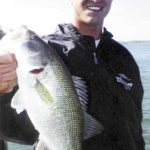
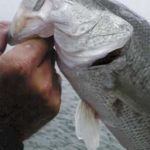
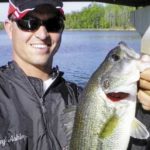
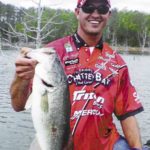
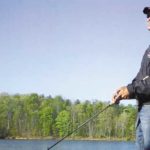


Be the first to comment